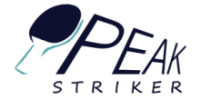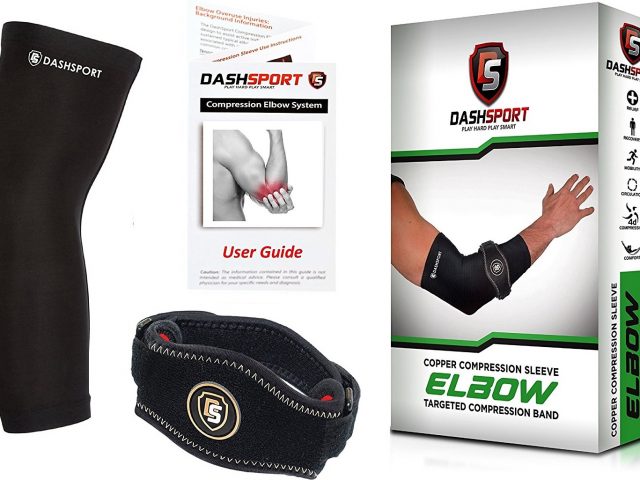We take a look at what goes into making the best tennis ball machine and what you should look for to decide which one is good for you. We then give you our top picks with 5 tennis ball machine reviews.
| Picture | Ball Machines | Review | Available |
|---|---|---|---|
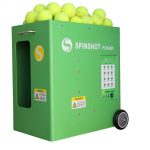 | Spinshot-Player Tennis Ball Machine | Our review | |
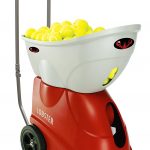 | Lobster Sports Elite 1 | Our review | |
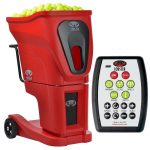 | Lobster Sports Phenom II Club Series Machine | Our review | |
 | Tennis Tutor Plus with Heavy Duty Battery | Our review | |
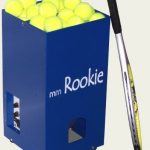 | Match Mate Rookie Tennis Ball Machine | Our review |
A serious player who wants to improve their game and skill may not always have a partner to practice with, or they may simply wear their partners out.
While a machine can not completely replace practicing with a partner, it can go a long way in improving your game. There are also some things a machine can do better than a practice partner can, so they are an investment worth making.
- A tennis ball machine will not quit on you (unless the battery dies).
- A tennis ball machine will not complain when you assign it the task or shooting the same shot repeatedly so you can perfect a technique.
- A tennis ball machine won’t show up late for practice or call off due to illness either.
Tennis ball machines are also great for beginners who are simply looking to learn the mechanics of a good swing.
With a little creativity and a one of the best tennis ball machine you can design a practice routine with enough variation to take you to the next level.
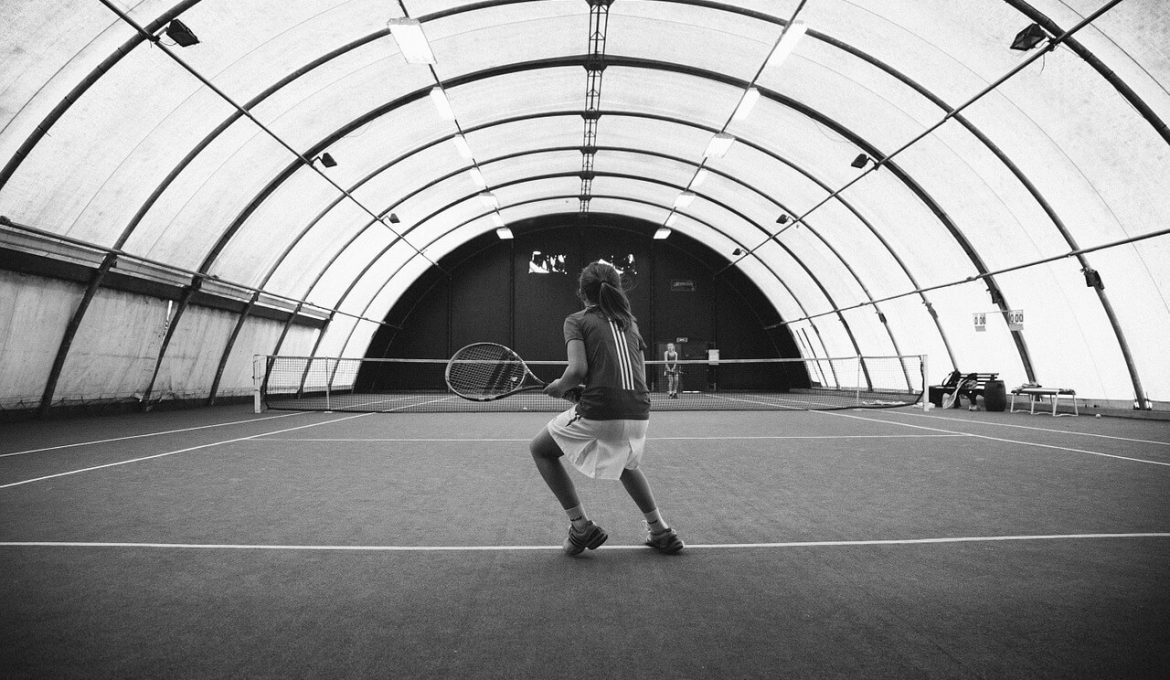
While you are designing your practice routine, do not neglect to practice your serve. It is the only shot you will hit more or less the same, that you do not need a machine to practice, and is a critical move in your game.
Speaking of practice routines, start with the end in mind. What is your goal and what exactly do you want to accomplish by practicing with a machine.
You can get more or less out of a machine, it’s the purposefulness and planning you put into your routine, and your consistency with and commitment to practice, that make the real difference.
With that out of the way, let’s take a look at the factors you should consider when asking yourself the question “What is the best tennis ball machine?”
Programming
Do you want a machine that can be programmed to use a variety of speeds different feed rates, various spins and so forth? Is it important to you that the machine has programmed or customizable drills?
These features cost more, but they are a convenience and help your game. Look at what the machine can be programmed to do.
Ball Capacity
How many balls can the machine hold? This is a basic characteristic and is usually not the sole deciding factor, but it’s good to know. The machines we reviewed have from 120 to 300 ball capacities.
Power Source/Battery Life
This characteristic is more important. If you are buying the machine for a club, or charging the battery will be an inconvenience, or 4 to 6 hrs of play time is not sufficient, you will need an AC powered machine vs battery.
If portability and the ability to play away from a power source are priorities, you need a battery powered machine.
Some machines have an option for both at an additional charge, some others offer rapid chargers that can be plugged in and charging and operating at the same time.
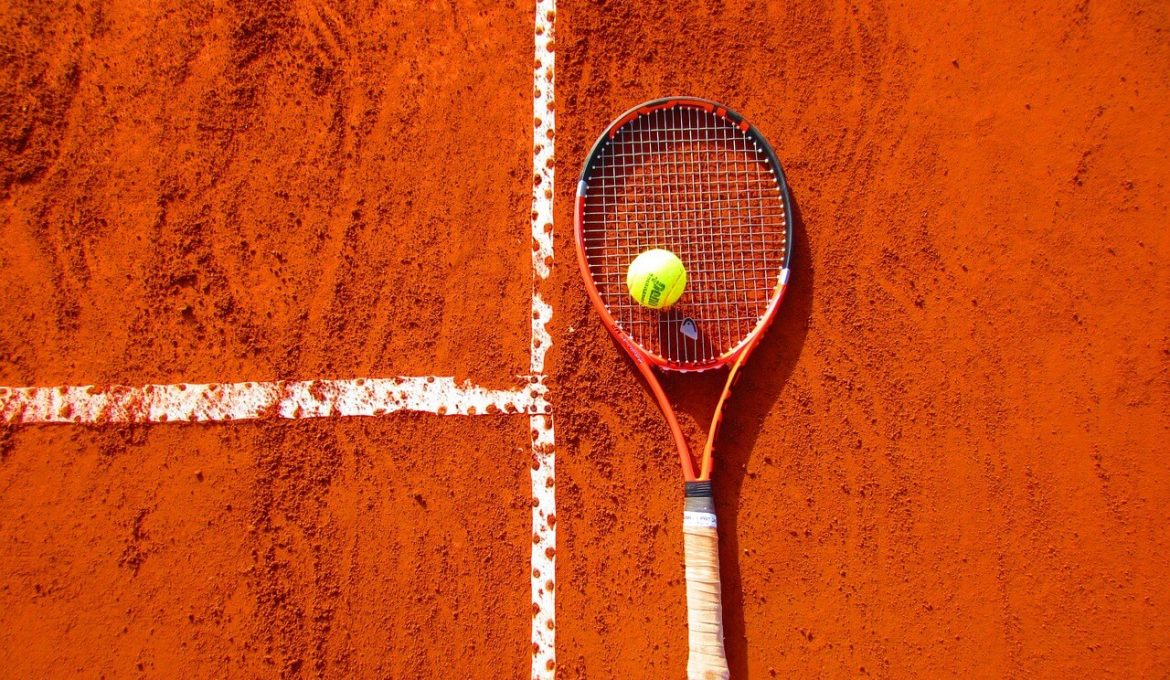
Propulsion Method: Two Wheel vs Pneumatic
Pneumatic machines are the old school style machine where motor pops a ball out thru a tube using air pressure. These machines are less expensive, noisy and do not have the features the ‘two wheel’ style machines have.
Pneumatic machines also use more power relative to other machines and therefore can not be battery powered.
The machines that use two wheels rotating in opposite directions, have what’s known as oscillation, which allows for more features and is usually more expensive, but quieter.
The ball is fed into a gap between the wheels and is popped out by pressure between the wheels. The oscillation can change the speed and spin of the ball.
Horizontal Oscillation will throw the ball to the top left or top right corners of the court, for backhand, center and forehand positions.
Vertical Oscillation will throw the ball closer to the net and allows depth of short vs deep.
Portable or stationary?
Do you need to travel with the machine, or take it to the court? Or will it be at a location where it can be stored near the court perpetually. If you do need a portable machine be sure to find out the weight and if it has wheels are durable handles to carry it.
The majority of tennis ball machines will have wheels and handles, the exception being Tennis Tutor which only has handles. But, just because they have wheels and handles does not make them portable.
The Tennis Tutor is portable, because the feed bin collapses and it is a compact unit.
Club grade machines that have handles and wheels can weigh hundreds of lbs and are only meant to move on and off the court, or to the clubhouse.
Elevation
If a machine offers elevation it will be electric or manual. Electric elevation can be controlled by a remote, which is usually an additional feature and expense, or by the control panel on the unit.
Manual controlled elevation must be set manually each time you want to adjust the elevation, so that can be time consuming. Some machines offer no elevation settings at all.
Speed range
How fast it can shoot the ball? Can the speed be varied? Can the machine be programmed to switch up and vary the speed between shots?
Different machines have different top speeds. An advanced player will need a high speed machine to mimic pro shots, but a beginner may be able to use a less expensive model with lower top speed.
Feed rate
This is the time between shots. Can the time between shots be changed or programmed? For a doubles practice session where you are both being shot balls, you need a machine that has a small interval between shots to keep you both on your toes.
Remote?
Many cheap tennis ball machines will not have a remote. Some machines provide a remote as an extra feature. More and more machines on the market offer a remote ‘app’ which you install on your smartphone.
A remote can save you time and encourage variation in play, so it is a feature to look out for.
Brands
There are several manufacturers of tennis ball machines. Remember, just because one brand may offer more of cheap tennis ball machines, doesn’t mean they lack quality.
Tennis Tutor makes reasonably priced portable machines and they have good customer service.
Tennis Partner offers a budget price machine.
We include Lobster tennis ball machine reviews in our top 5 as Lobster has a huge variety of machines on the market.
Spinshot and Match Mate have durable metal machines available. Spinshot has several levels of machines and prides themselves on drill programmability.
Our 5 Best Tennis Ball Machine with Reviews
Spinshot-Player Tennis Ball Machine with Phone Remote Supported
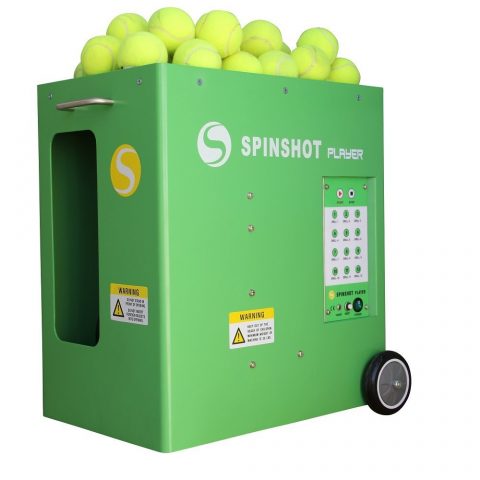
Click Here for Pricing, Pictures and Reviews on Amazon.com
- Ball Capacity: 120
- Power Source/Battery Life: Battery or AC (extra)
- Oscillation: Vertical/ horizontal
- Portable? Weight: Yes. 46 lbs for battery operated
- Elevation Trajectory /Height Control: Yes
- Speed Range: 18 to 68 mph
- Feed Rate: 2 to 10 sec
- Remote: Remote app for android and the iPhone
- Programming: 12 programmable 6 shot drills, ball position, speed and feed rate can be set.
PROS
- Durable metal machine
- Highly programmable
CONS
- Only remote available is a phone app, no stand-alone remote
- Quirky app programming
- AC power is an additional cost
- The settings can be hard to figure out
REVIEW
This is a portable machine, made from metal and quite durable. It has the option to use battery, included in the cost, or an AC feature which is extra.
Many machines do not offer both, so this is a great feature, therefore included on the list of our tennis ball machine reviews. Spin, speed, feed rate and height are adjustable features.
Lobster Sports Elite 1 Portable Tennis Ball Machine
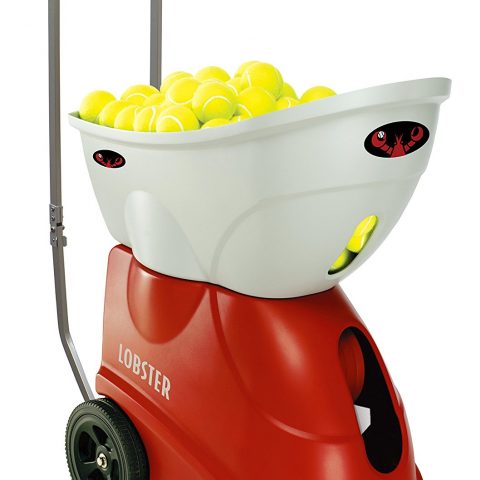
Click Here for Pricing, Pictures and Reviews on Amazon.com
- Ball Capacity: 150
- Power Source/Battery Life: Battery 4 to 8 hours
- Oscillation: Random horizontal
- Portable? Weight: Yes. 42 lbs
- Elevation Trajectory /Height Control: 0 to 60 degree range.
- Speed Range: 10 to 80 mph
- Feed Rate: 2 to 10 sec
- Remote: Sort of. Machine must be shipped to have a remote option installed and the remote is extra.
- Programming: Topspin backspin, lob and elevation. Mo drills
PROS
- Durable
- 150 ball count
- Reasonable price
CONS
- No light indicator to see if the feed is running
- Remote option is weak, must be close to unit
- Some users report battery problems
REVIEW
This is a durable entry level battery operated machine. It is great for individual play for beginner to intermediate levels.
It is a bit heavy and awkward due to the handle, but it is also one of the more durable machines on the market. You can adjust the spin and lob, to add variation to your routine.
Lobster Sports Phenom II Club Series
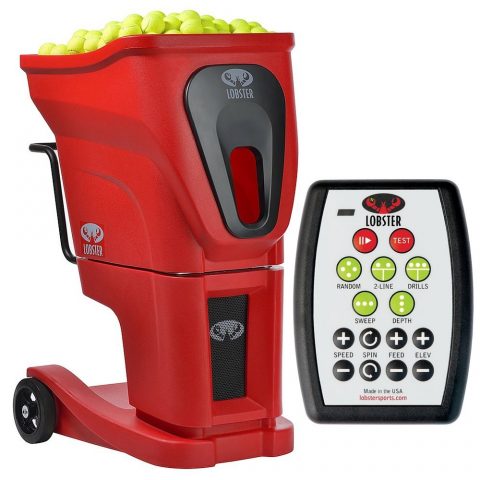
Click Here for Pricing, Pictures and Reviews on Amazon.com
- Ball Capacity: 250
- Power Source/Battery Life: AC
- Oscillation: Yes, horizontal, vertical, 2 line.
- Portable? Weight: Yes, 99lbs
- Elevation Trajectory /Height Control: Electric 0-50
- Speed Range: 35-85
- Feed Rate: 2 to 9 seconds
- Remote: Extra
- Programming: 12 preprogrammed drills, 18 ball positions. Topspin, backspin, feed rate, elevation, this machine has just about everything.
PROS
- 250 ball capacity
- 12 custom court drills with 6 shots each
- Large wheels for transport
CONS
- The remote is separate/ optional
- It needs a feed light indicator
REVIEW
This is an intermediate to advanced and even club level machine as the name indicates. It is not exactly portable at 99 lbs, but it does have wheels and a handle so it can be moved if needed.
It has a huge range of options a programmability so you can fine tune your routine, plus it holds 250 balls for extended play. This is a high performance machine built to last.
Tennis Tutor Plus with Heavy Duty Battery
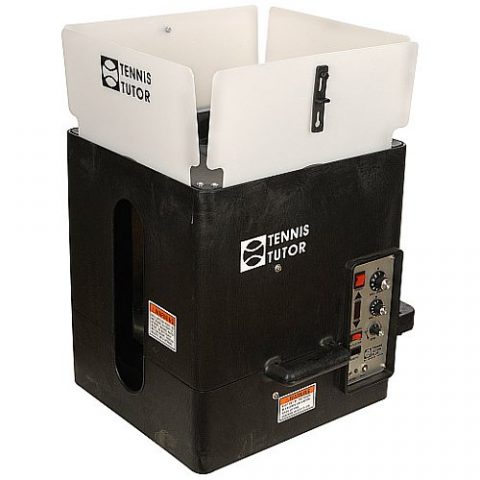
Click Here for Pricing, Pictures and Reviews on Amazon.com
- Ball Capacity: 150
- Power Source/Battery Life: battery 4-6 hrs
- Oscillation: Speed, elevation, spin (top/under), interval, oscillation (random, 2 line narrow, 2 line wide
- Portable? Weight: Yes, 46lbs
- Elevation Trajectory /Height Control: Yes, groundstroke to lob with elevation display
- Speed Range: 10 to 85 mph
- Feed Rate: 1.5 to 10 sec
- Remote: Fully functional remote with beeping indicators
- Programming: No drills. Can set speed, feed rate and elevation.
PROS
- Folding ball hopper
- Two way remote available
- Topspin and under spin available
- High top speed
- This machine can make repeat or repetitive shots to refine a technique
CONS
- No programmable drills
REVIEW
This is a quality machine and the manufacturer obviously put a lot of thought into the details. The knobs are intuitive and easy to set, the indicators are helpful and make operation easy to understand.
It would be nice if the remote was included, and not extra. It would also be a good feature to have programmable drills.
This is one of the faster machines on the market, with a huge range of adjustments and the machine works for beginners all the way to pros. It is portable and battery operated, but because of its quality, it can work at a club as well.
Match Mate Rookie Tennis Ball Machine
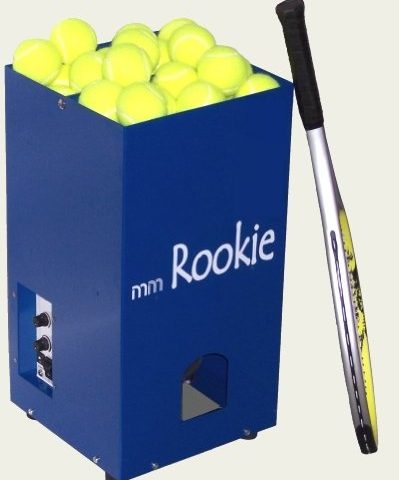
Click Here for Pricing, Pictures and Reviews on Amazon.com
- Ball Capacity: 70
- Power Source/Battery Life: Battery 5 hrs
- Oscillation: No oscillation
- Portable? Weight: 22lbs
- Elevation Trajectory /Height Control: Manual with elevation pegs
- Speed Range: 10 to 28 lbs
- Feed Rate: Adjustable
- Remote: No
- Programming: No drills programmed into the machine. Can set speed, feed rate and elevation.
PROS
- All aluminum frame
- Lightweight and durable
- 5 hrs battery life
CONS
- It has no preset drills
- It also is not super fast, it is meant for entry level play
REVIEW
This is a well-built basic beginner’s machine that reliably gets the job done and works as advertised. It does not have the options that a higher end model has, but it also does not have a high price tag, making this unit accessible.
It is still a quality unit, budget price, but not a cheap tennis ball machine. You must move the unit to adjust court position, or where the ball lands, but at 22 lbs it is not too much of a chore.
That wraps up our tennis ball machine reviews. We hope this helped you decide on the best tennis ball machine for you.

